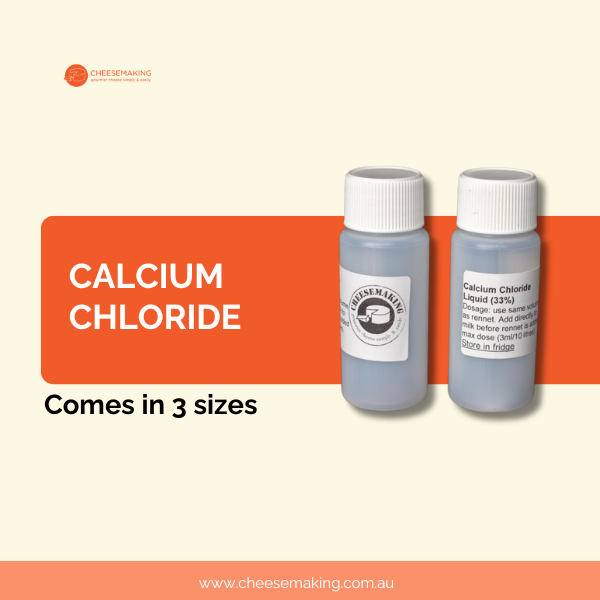- 33% available calcium
- CaCl2 is added to milk to compensate for the loss of calcium available for coagulation of the curd when rennet is added.
- The loss of calcium in milk may occur for several reasons eg pasteurisation, milk age (fresh milk is best for many reasons), drought, breed and individual animal variation, seasonal variations plus more. If the available calcium is precipitated or lost, then it is not available for coagulation when the rennet is added. This will give you a weak and soft curd, cause loss of proteins, poor drainage, over acidification etc.
- Calcium chloride is added to milk to help correct any calcium deficiencies in the milk to improve or speed up the setting ability of the milk.
- Some milks you use may require the regular addition of calcium chloride to the milk and some do not. If you are unsure which type of milk you are using, then add the calcium chloride as a precautionary measure. It will not detract from the cheese in any way.
- It is important this is done after the milk is pastuerised.
- When measuring the dosage, high accuracy is not required. Dosage should be approximately 3 mL per 10 litres in most cases, however if sets are very poor then increase this to 4.5ml per 10 litres. Often 1ml to 2ml to 10 litres or nil addition is used if the milk is very good quality.
- A syringe or similar is used for measuring the CaCl2, wash and reuse the same syringe for Annatto, liquid blue mould spores and rennet. I wash the syringes in soapy water and rinse for storage. Only sanitise the syringes in boiling water prior to use, no chemical sanitisers should come into contact with these ‘ingredient use’ syringes.
- Raw milk has a higher level of calcium than that same milk that has been pasteurised. Pasteurisation precipitates some of the calcium in the milk. Excessive pasteurisation (from home or commercially) will precipitate even more calcium again.
- Important note: It is important to add the calcium chloride at least 1 hour before you add the rennet. The calcium needs this time to bind with the proteins and phosphorous in the milk. Ideally add it to the milk as soon as it is warned up to cheesemaking temperature eg even before you add the starter cultures.
- Comes in a resealable plastic bottle and can be stored at ambient temperature, in the fridge or the freezer.
- Calcium Chloride will last indefinitely.
- Calcium is also used for the addition to saltwater brines, for salting cheese and for storing cheese and to washed used to wash the rinds of cheese. It is also added to brines storing fresh mozzarella. Suggested rate of additional is 2ml of CaCl + 0.2ml of vinegar per litre of brine, however this can vary with different cheeses.
- Milk from Jersey and Guernsey cows have naturally high levels of calcium. This in not implying that other breeds such as Friesian and Illawarra etc. do not have high levels of Calcium in their milk.

Calcium Chloride
$3.00 – $25.00
